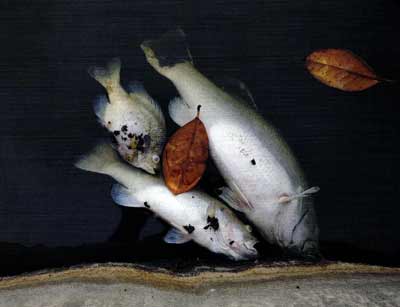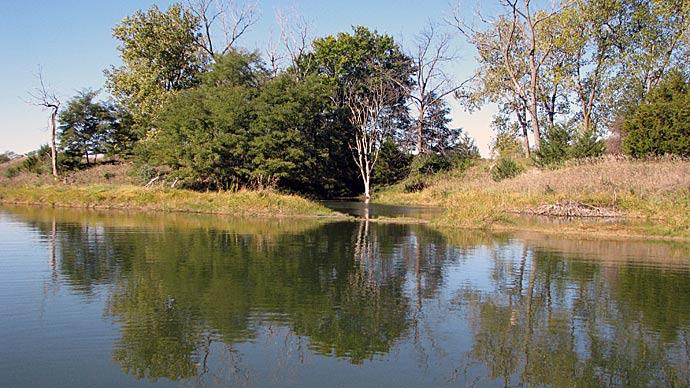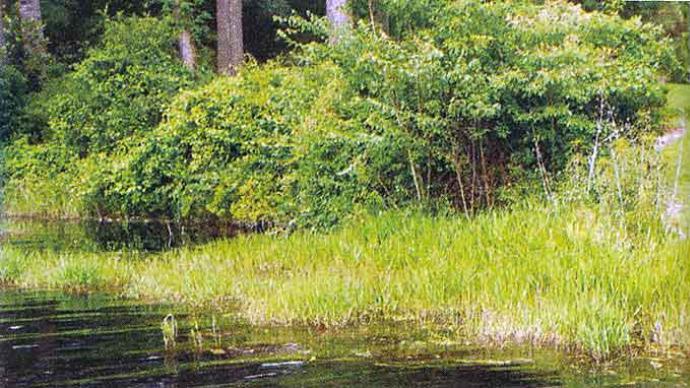
We have several ponds on my university's campus that are stocked and often fished, but our facilities managers never contact me unless there is a problem. I cannot keep track of how many times they have taken pond management action without consulting me or, worse, consulted me and then ignored my advice. Then when it all goes bad, they call me to fix it.
Such was the case in late May when I got a call that "A turnover has killed Eicke's Pond!"
Eicke's Pond is a small pond about 1.5 acres in surface area with seawalls around most of the shoreline. The pond has a history of landscape fertilization, ducks and geese, and other sources of nutrients, with tremendous nutrient loads stored in the sediment. It is overstocked with fish and has annual bouts with cyanobacterial blooms in the summer. It is a disaster waiting to happen.
It holds the distinction of being the oldest leveed pond in Mississippi; at least that's what I have been told. It also holds the distinction of being right in front of the university president's residence, so when there's an issue, it is an emergency!
The lake has abundant populations of bass and bream because fishing is not allowed. It also has a healthy population of jumbo-sized koi in all shapes and colors. These are especially important to the wife of the university president, as she likes to feed them and has each fish named. So, I needed to run and save the koi.
When I arrived, two facilities management employees were onsite and dipping up dead fish. A quick survey of the pond told me right away that losses were minimal. They had a 5-gallon bucket about a third full of bass and bream, and there might have been enough fish around the pond's shoreline to fill the bucket perhaps two-thirds full.
No koi had died, but those big bright fish were up on the surface piping for oxygen. Between the koi and 40 gazillion little bream at the surface, the pond looked like it was experiencing a light rain despite the clear blue sky.
Next, I noticed the water's color, which did not look too far off the normal brownish-green color. Not the strange clear-brown color characteristic of a severe turnover event.
It was clear to me that this was not a traditional pond turnover. Turnovers happen when deeper water, which is colder, heavier, and contains no oxygen, suddenly mixes with the warm oxygenated water at the surface. The result can be a near-complete fish kill, with all species and all sizes dying as they struggle to breathe.
This was more likely an oxygen depletion caused by high productivity and warm water temperatures. Oxygen is produced by the phytoplankton when there's sunlight. When the sun goes down, everything uses up oxygen, including phytoplankton. Thus, oxygen concentrations increase throughout the day and then decrease overnight. Oxygen is generally lowest right at daybreak. So, when productivity is high, oxygen is produced quickly during the day and used up quickly at night.
Also, less oxygen dissolves in water as temperature increases. When summer heats up, the maximum concentration (saturation level) of oxygen goes down. It doesn't really matter how much oxygen is produced during the day, because the excess is lost to the air via diffusion once the water becomes saturated with oxygen. To make this scenario more dangerous, as temperature goes up, metabolism by bacteria, plants, and animals goes up, requiring more oxygen. Thus, it is not uncommon for a pond to reach dangerously low oxygen levels early in the morning.

Most of the time, this does not result in a large-scale fish kill. Perhaps only part of the pond dipped below minimum oxygen levels, and most fish could escape. Or perhaps the whole pond got dangerously low, but the sun rose and increased oxygen before too many fish were lost. Either way, this is a warning sign that conditions are favorable for the same or worse to happen in the coming days.
Oxygen depressions can be a chronic problem that last days or even weeks. Even when losses are minimal each night, those losses can add up over the course of many nights. More often, the next night can be more severe than the previous because oxygen levels cannot recover sufficiently from the previous day's low.
These low oxygen events are quite common in southern ponds during the summer. They can even go unnoticed when you infrequently visit the pond. However, if you do see it happening, there is usually time to do something about it.
You need to provide emergency aeration to the water immediately. Anything you can do in a pinch to churn up water and add oxygen will help to provide an oxygenated refuge. The key is to create whitewater - a sure sign that you are infusing oxygen into the water.
Surface aerators are best, but most people don't have immediate access to these unless they live in an area where pond aquaculture is common. Other makeshift solutions can include partially backing a boat and motor in the pond and running the motor at an angle to throw a "rooster tail" across the surface, or I have heard of people dropping the bush hog of a tractor into the surface of the water and churning the water.
Fountains, water pumps, and sprayers often don't help very much because they do not move much water, or they don't agitate the water enough to dissolve substantial amounts of oxygen. Also, if you pump water from a well, make sure it goes through a whitewater stage before entering the pond, as well water has no oxygen and may contain other gases and minerals that need to be off gassed or oxidized.
Regardless of your emergency triage, understand that you may need to continue treatment for several days. It takes awhile for the conditions that led to the oxygen depression to run their course.
Back to Eicke's Pond... The university conveniently has an aquaculture research program, so I had several surface aerators at my disposal. Being on campus there was electricity close by, so we could run an extension cord to the pond edge to power the aerators.
Facilities management launched a tiny 10-foot johnboat loaded with two 50-pound cement anchors and a 200-pound man into the pond. They could not find a paddle, so they used a shovel to propel the unstable boat. I stayed on shore and recorded video in case something hilarious happened.
The employee towed the aerators one at a time out to the deepest part of the pond and anchored them in place using the heavy anchors. We watched with satisfaction when the aerators were activated, and they kicked two white cones of water across the pond surface.
The next morning the only dead fish were those that had died previously and finally floated up. There were still some fish piping in the shallow areas away from the aerators, indicating oxygen was still low in parts of the pond, but most of the fish were stacked up between the aerators and the seawall. It is quite a sight to see 15-pound koi and tiny bream so concentrated.
The following morning, all piping had stopped, and the fish had dispersed, suggesting that oxygen levels were returning to normal. Still, I think I will leave the aerators in for a while!
The long-term solution I recommended is to purchase and install a destratification system. However, the university keeps pushing for an ornamental fountain instead because they believe that rising bubble columns are unsightly. I have explained that most fountains don't move enough water to prevent future fish kills...but I expect to soon see a fountain spraying innocuous jets of poorly aerated water. I am sure they will call me for advice when fish start dying again.
Dr. Wes Neal, Extension Professor at Mississippi State, serves as State Extension Fisheries Specialist, passionate about educating the public on small lake and pond management. He is an avid researcher on topics from farm pond management to sport fish genetics. Wes is lead editor of Small Impoundment Management in North America, the only textbook on the subject. He loves to hunt and fish, wes.neal@msstate.edu.
Reprinted with permission from Pond Boss Magazine



